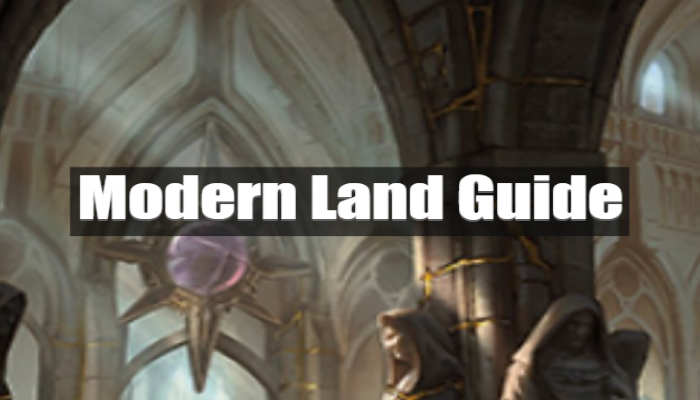Lands are the foundation of most Magic: The Gathering decks. They give you the resources to cast your spells, and in formats like Modern, where many decks are two, three, four, or even five colors, finding the right lands for your decks can make or break your build. So, today I’ll cover the options for lands in Modern MTG and when you should play them.
Modern has access to a plethora of dual lands (shock lands, check lands, and fast lands), tri-lands (Ikoria and New Capenna “triome lands”), and powerful utility lands that do things besides tap for mana. There are also fetch lands, that really help to enable Modern decks to splash colors and run up to five colors without issue – Assuming you build the deck correctly.
Suppose some of these terms are new to you; worry not. I’ll be breaking down each land cycle mentioned above (as well as many more) in detail below. If you play Modern MTG and are looking for what lands you have available, you’re in the right place. So, without further ado, let’s jump in.
Lands For Modern MTG
Here you’ll find a breakdown of each land cycle in Modern with a brief rundown of how they work and when you’d want to use them.
Fast Lands
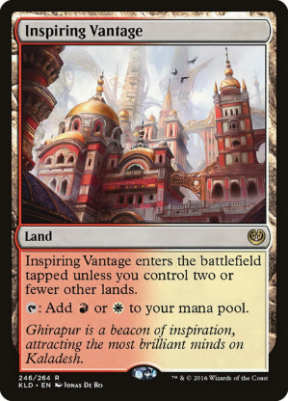
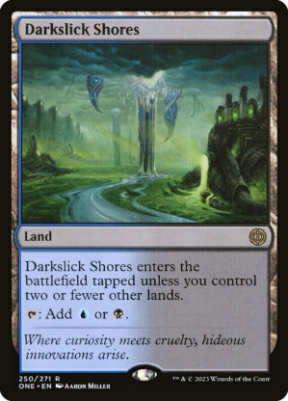
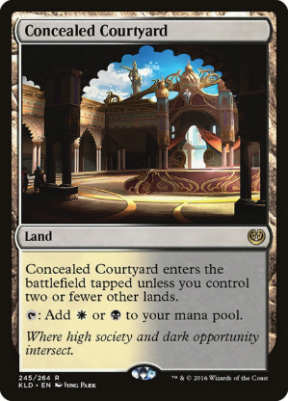
Fast lands get their name because they’re great in the early game, which makes them “fast” at producing mana. There is one land for each color pair, and they enter tapped if you control two or more other lands as they enter. This means they get slightly worse as the game goes on. However, the first few turns are crucial in Modern.
Related: MTG Dual Lands – All Your Questions Answered
You’d want to play these in almost all two, three, or maybe even four-color decks. In the early game, they come in untapped for no downside and help to get your deck on the right track right out of the gate. That said, if you have critical spells that must come out on a more costly curve, ensure you have other duals for later in the game, as these will come in tapped past turn two if you’re making land drops.
Here is the complete Modern fast land list:
- Seachrome Coast
- Darkslick Shores
- Blackcleave Cliffs
- Copperline Gorge
- Razorverge Thicket
- Concealed Courtyard
- Blooming Marsh
- Botanical Sanctum
- Spirebluff Canal
- Inspiring Vantage
Check Lands
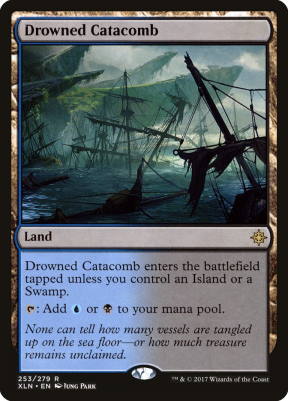
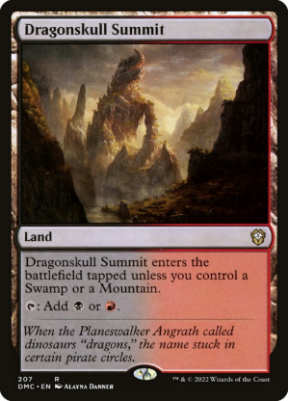
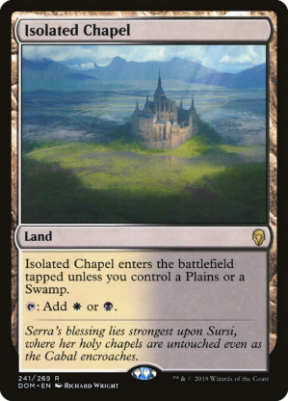
Check lands get their name because they “check” to see if you control a land type and enter untapped if you do. Each one produces two colors of mana and will enter untapped if you control land with either basic land type that it can produce. So, for example, an Isolated Chapel produces black or white mana and will enter untapped if you control a plains or a swamp.
These are best alongside other lands that have multiple land types (like Godless Shine or Salvi Triome) or a high number of basic lands. That said, if you’re building on a budget, these can be good options for dual lands. If you don’t play enough of the requisite land types, just be prepared to have them enter tapped on the first turn or two.
These are all 10 check lands available in MTG:
- Glacial Fortress
- Drowned Catacomb
- Dragonskull Summit
- Rootbound Crag
- Sunpetal Grove
- Isolated Chapel
- Sulfur Falls
- Woodland Cemetery
- Clifftop Retreat
- Hinterland Harbor
Shock Lands
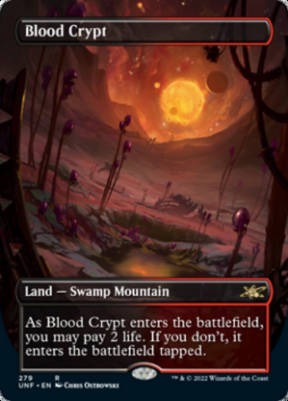
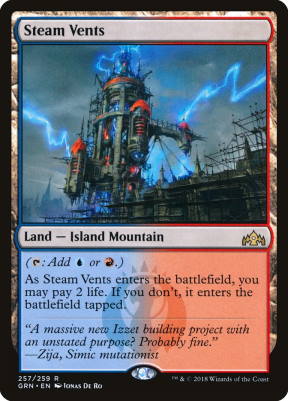
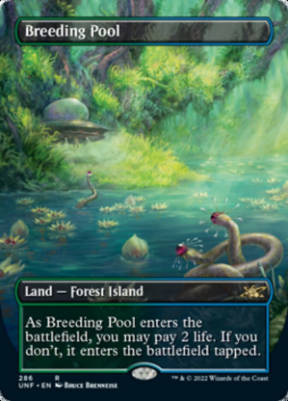
Shock lands are some of the most essential lands in Modern for multicolored decks. The term “shock” lands come from them dealing you two damage (like the card Shock) to come in untapped. All other lands previously mentioned have had some condition you had to meet to use the land the turn you play it—no matter the turn or your
This versatility, alongside the fact they have two basic land types (which is phenomenal with check lands and fetch lands), makes them invaluable for multicolored decks in Modern. If your deck has more than one color and you can afford them, you’ll 100% want them in it. Two life is a small price to smooth out your mana base. And you can always let them enter tapped in a pinch.
Here are all ten shock lands:
- Hallowed Fountain
- Watery Grave
- Blood Crypt
- Stomping Ground
- Temple Garden
- Godless Shrine
- Overgrown Tomb
- Breeding Pool
- Steam Vents
- Sacred Foundry
Fetch Lands
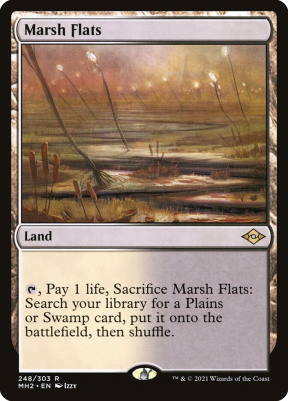
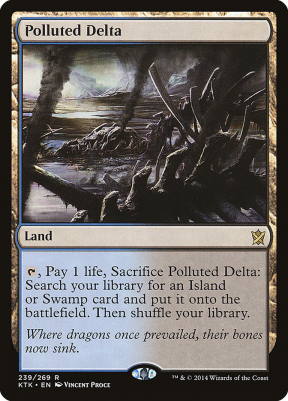
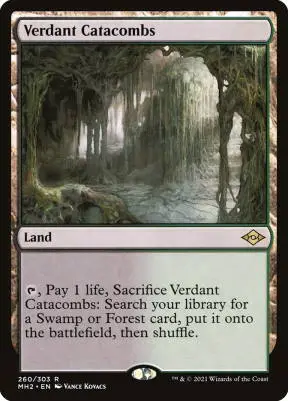
Fetch lands may be the most crucial land in Modern for playing a deck with a complex mana base of many colors. Termed fetch lands because they fetch other lands from your deck; their effectiveness at giving you the mana you need when you need it is unrivaled. Each can “fetch” any land with a basic land type of one of its two colors by tapping, paying one life, and sacrificing the fetch land.
As an example, Bloodstained Mire (the black/red fetch land) can get any land that says “mountain” or “swamp” in the land type section. Not only can this grab Blood Crypt but things like Godless Shrine (because it says swamp) and Steam Vents since it is a mountain.
Related: MTG Fetch Lands – What Makes Them So Good?
This makes them incredibly valuable to decks playing multiple colors and cards with greedy mana costs. This “fetchability” also further illustrates the point of what the basic land types on shock lands so good. But back to fetch lands, they also come in clutch for triggering abilities like landfall since they’ll trigger it once themselves and again for the land you fetch.
They can have yet another upside when triggering abilities like revot (on Fatal Push, for example) or adding the land card type to the graveyard for things like Unholy Heat. Fetch lands do more than any other land when it comes to guaranteeing a particular land at the right time.
Here are all ten fetch lands:
- Flooded Strand
- Polluted Delta
- Bloodstained Mire
- Wooded Foothills
- Windswept Heath
- Marsh Flats
- Scalding Tarn
- Verdant Catacombs
- Arid Mesa
- Misty Rainforest
Artifact Lands
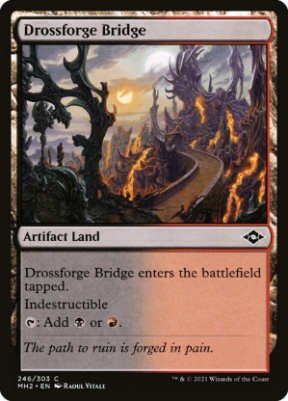
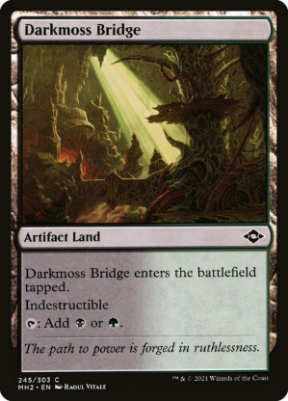
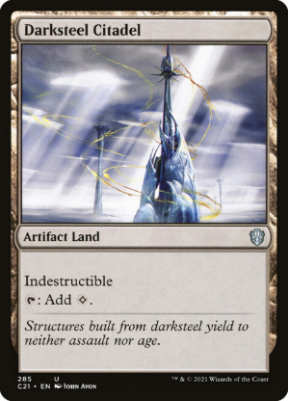
Artifact lands are pretty straightforward – They’re lands that produce mana, and they’re also artifacts. Why would this be useful? Any deck built around artifacts significantly boosts how many they can get into play running these lands. For example, “affinity” decks play cards like Thoughcast, Thought Monitor, Frogmite, and Cranial Plating all of which want artifacts in play as early and often as possible.
If you’re building a deck that cares about artifacts, these will be your go-to lands in many circumstances. If you don’t have any synergies with them, you probably won’t be using many of these. However, the dual artifact lands can be ok budget lands alongside anything that cares about multiple basic land types in play.
Here is a list of all Modern legal artifact lands:
- Razortide Bridge
- Mistvault Bridge
- Drossforge Bridge
- Slagwoods Bridge
- Thornglint Bridge
- Goldmire Bridge
- Silverbluff Bridge
- Darkmoss Bridge
- Rustvale Bridge
- Tanglepool Bridge
- Power Depot
- Darksteel Citadel
Horizon Lands
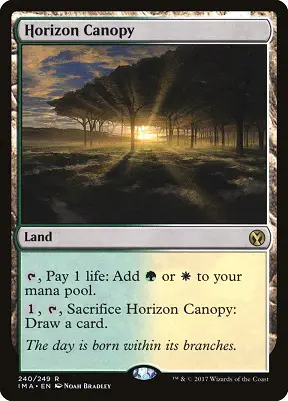
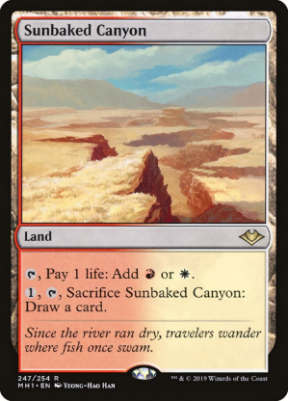
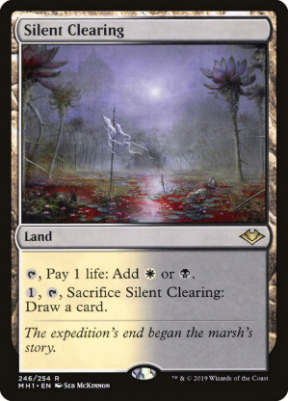
“Horizon” lands take their name from Horizon Canopy. Until Modern Horizons, it was the only land to pay one, tap and sacrifice itself to draw a card. This upside is balanced because it deals one damage to you whenever it’s tapped for mana. Now there is a complete cycle of lands with this ability, and each color pair has its own.
In my experience, you can play these whenever your deck can support them. By this, I mean a few things. First, your deck doesn’t mind losing access to land later in the game – You’ll have one less land after using this and have to tap one mana to activate it. For some decks, this work well.
The next consideration is that they damage you. If you play these alongside shock lands, fetch lands, and modern staples like Thoughtsieze, you could deal yourself a lot of damage. So, be cautious of that, especially if you play in an aggressive meta.
That said, if you don’t mind taking the ping, want to reduce the chances you get mana flooded, or really need access to more card advantage, these can be great options. You can even use these with great success in certain mono-colored decks. A good example would be mono-red burn playing Sunbaked Canyon.
A card list of horizon or canopy lands is as follows:
Creature/Man-lands
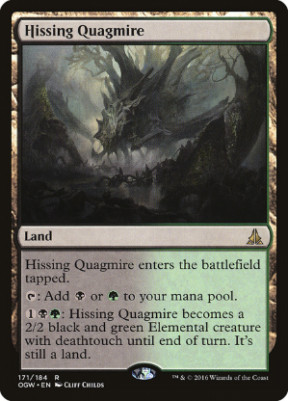
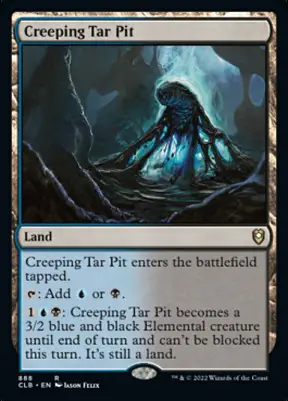
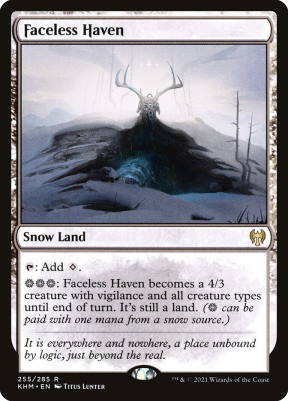
Lands that can turn into creatures for a turn are often called “man lands.” They usually enter the battlefield tapped, tap for mana of their respective colors, and have abilities that allow them to become a creature for a turn. However, they’ll still be a land too. This makes them susceptible to both creature and land removal.
When you should or shouldn’t play these varies some. If it’s super essential to cast spells on a curve, these might not be great because, as mentioned, they do usually enter tapped. The same could be true of super-aggressive decks – You’ll want to play creatures that can come in and add power and toughness to the
On the contrary, if you play a slower, more controlling deck that needs dual lands, you can get away with playing a few of these. They’re fantastic for grindy, long-game, midrange, and control decks and can add a lot of threat density (and mana-fixing) to decks that can support them.
Below you’ll find a list of all currently Modern legal manlands:
- Blinkmoth Nexus
- Crawling Barrens
- Dread Statuary
- Faceless Haven
- Frostwalk Bastion
- Hostile Desert
- Inkmoth Nexus
- Mishra’s Foundry
- Mobilized District
- Mutavault
- Nantuko Monastery
- Stalking Stones
- Svogthos, the Restless Tomb
- Westvale Abbey
- Zoetic Cavern
- Forbidding Watchtower
- Faerie Conclave
- Spawning Pool
- Ghitu Encampment
- Treetop Village
- Cave of the Frost Dragon
- Hall of Storm Giants
- Hive of the Eye Tyrant
- Den of the Bugbear
- Lair of the Hydra
- Celestial Colonnade
- Creeping Tar Pit
- Lavaclaw Reaches
- Raging Ravine
- Stirring Wildwood
- Shambling Vent
- Wandering Fumarole
- Hissing Quagmire
- Needle Spires
- Lumbering Falls
Filter Lands
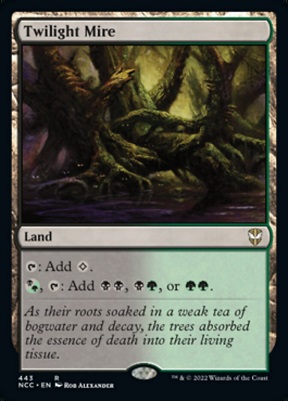
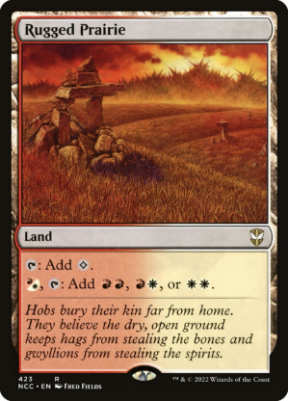
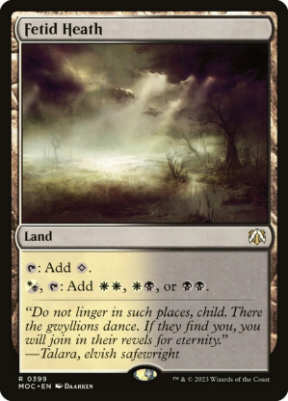
In some instances, filter lands are a lifesaver and can support cards you otherwise wouldn’t be able to play in the same deck. They require one mana of any color the land can produce and then can tap for two mana of either color the land makes or one of each.
For example, you can tap a plains and Fetid Heath and get two black mana. In other words, it filters your mana from white to black. This can be helpful if you’re playing a deck where many cards have multiple colored mana symbols. A b/w deck with Brought Back, Gifted Aetherborn, and Cruel Celebrant could find themselves unable to cast some cards reasonably easily.
Filter lands shine here – Even with only one in play, you can access both your colors, even in particular combinations. The only downside is that they aren’t great on your first turn if you need to cast a colored one drop since they don’t make colored mana alone.
Here is a list of the 10 filter lands which see play in Modern:
- Mystic Gate
- Sunken Ruins
- Graven Cairns
- Fire-Lit Thicket
- Wooded Bastion
- Fetid Heath
- Cascade Bluffs
- Twilight Mire
- Rugged Prairie
- Flooded Grove
Bounce Lands
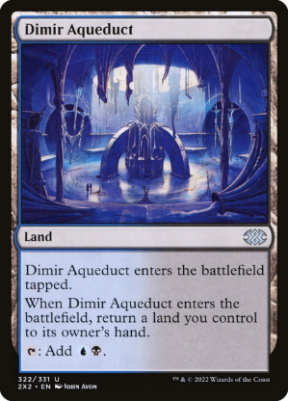
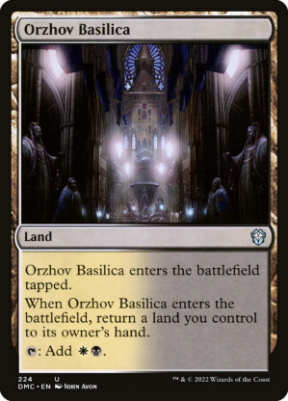
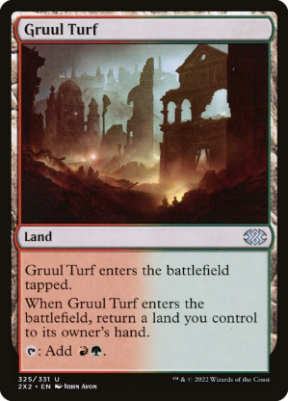
For the most part, bounce lands don’t see play in Modern. Granted, they produce two mana, but generally, they’re too slow. Not only do they enter tapped, but you’ll also have to “bounce” another land back to your hand. There is one exception, though. Any deck that plays Amulet of Vigor can produce tons of mana with these.
The Amulet makes it so the lands enter untapped, and you can tap them for two mana before you have to bounce it back to your hand. This sneaky way of stacking the triggers means you’ll immediately reap the benefits of double mana production while circumventing much of the downside.
These decks (Modern Amulet Titan) also play effects that let them play extra lands on each turn. Now you can deploy several bounce lands in one turn, use them right then, and cast some huge threats early. Outside of this particular deck, these don’t see much play.
Below you’ll find the complete cycle I’m referring to with “bounce land”:
- Azorius Chancery
- Dimir Aqueduct
- Rakdos Carnarium
- Gruul Turf
- Selesnya Sanctuary
- Orzhov Basilica
- Izzet Boilerworks
- Golgari Rot Farm
- Boros Garrison
- Simic Growth Chamber
Pain Lands
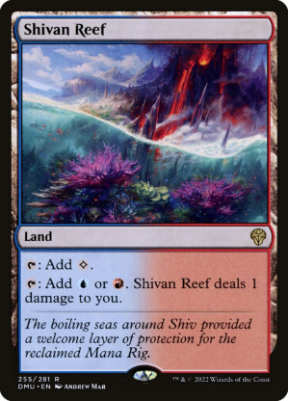
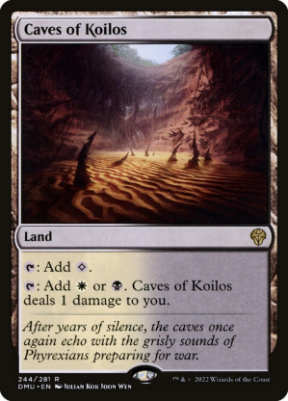
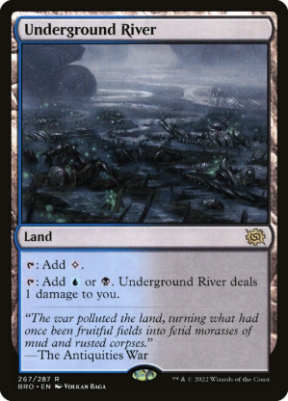
Pain lands are called such because they take some life every time you tap them for colored mana. So, using them is, well, painful. However, that’s their only downside. They’ll always produce the color you need as long as you are willing to pay life, and they’ll never enter tapped, which is excellent!
They are also cheap to buy compared to other dual lands, with many costing less than $1. As long as your deck/meta is ok with taking some damage, these can run two-color (or more) decks quite smoothly. In my deck-building experiences, these are the best Modern lands for those looking to compete on a budget.
Here is a list of the 10 Modern pain lands:
- Adarkar Wastes
- Underground River
- Sulfurous Springs
- Karplusan Forest
- Brushland
- Caves of Koilos
- Shivan Reef
- Llanowar Wastes
- Battlefield Forge
- Yavimaya Coast
Cycling Lands
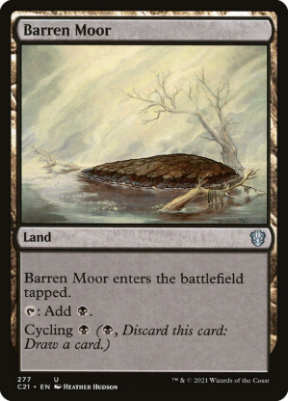
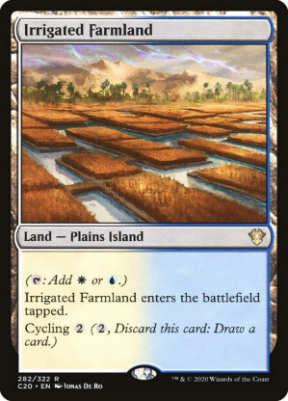
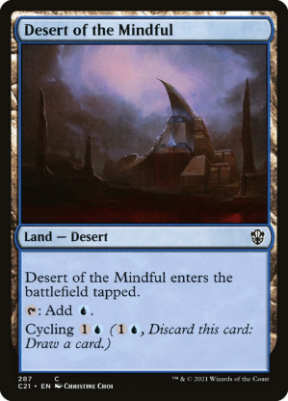
Like most things in MTG, Cycling lands are give and take. Their downside is that they always enter the battlefield tapped. However, to balance this, they have the upside of being able to be “cycled” away to draw a new card. These are great options for more controlling decks that don’t mind having some number of lands enter tapped.
Cycling your land is a great way to protect against mana flooding and makes you more likely to have quality top decks as the game progresses. Once upon a time, there were devoted strategies in Modern (such as Hollow One) that could draw extra value from cycling things. They don’t see competitive play anymore, but a few of these should probably be included if you’re building a cycling deck.
Here are your Modern legal cycling lands:
- Secluded Steppe
- Lonely Sandbar
- Barren Moor
- Forgotten Cave
- Tranquil Thicket
- Desert of the True
- Desert of the Mindful
- Desert of the Glorified
- Desert of the Fervent
- Desert of the Indomitable
- Irrigated Farmland
- Fetid Pools
- Canyon Slough
- Sheltered Thicket
- Scattered Groves
Scry Lands
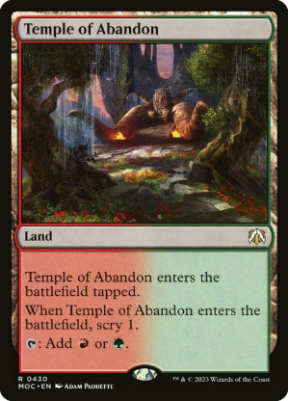
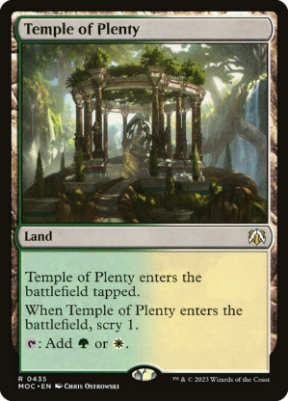
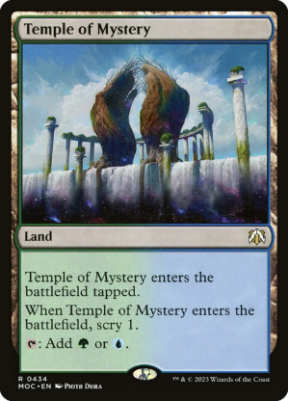
If I have to play dual lands that enter the battlefield tapped, the scry (also called “temple”) lands are my favorite. In my experience, the scry from these can be incredibly impactful compared to gaining one life. It doesn’t quite draw you a card or add to the
While playing tap lands will always slow you down, at least you get some tangible advantage from playing these. And they’re very cheap to buy. So, if you have to play tap lands, go for these – They’ll help smooth things out, ensure the rest of the deck functions to its full potential, and are some of the better Modern tap lands in MTG.
Complete list:
- Temple of Enlightenment
- Temple of Deceit
- Temple of Malice
- Temple of Abandon
- Temple of Plenty
- Temple of Silence
- Temple of Epiphany
- Temple of Malady
- Temple of Triumph
- Temple of Mystery
Pathway Lands
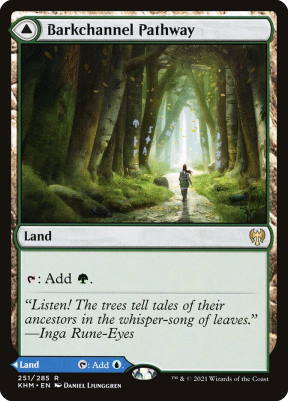
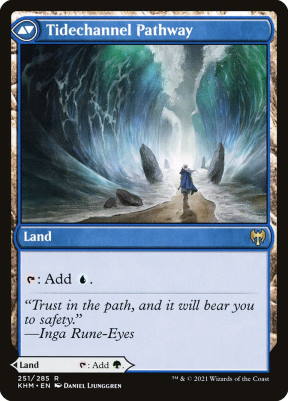
Pathway lands are what’s known as modal dual-faced cards, or MDFCs for short. This means they have different cards (in this case, a land) on the front and the back. When you play the card, you can choose which side you’d like to play. For example, a Barkchannel Pathway is a forest-producing land, and the other side Tidechannel Pathway produces blue mana.
Related: The Best Blue Removal In Magic: The Gathering
So, it can be considered a green and blue source (almost like a dual land) when deck building. However, once you play it, you’ll only have access to whichever side you choose, not both. When should you play these? In my experience, these are best when splashing for extra colors, and your cards don’t have too many colored mana pips.
A complete list of “pathway lands can be found below:
- Hengegate Pathway / Mistgate Pathway
- Clearwater Pathway / Murkwater Pathway
- Blightstep Pathway / Searstep Pathway
- Cragcrown Pathway / Timbercrown Pathway
- Branchloft Pathway / Boulderloft Pathway
- Brightclimb Pathway / Grimclimb Pathway
- Riverglide Pathway / Lavaglide Pathway
- Darkbore Pathway / Slitherbore Pathway
- Needleverge Pathway / Pillarverge Pathway
- Barkchannel Pathway / Tidechannel Pathway
Snow Duals
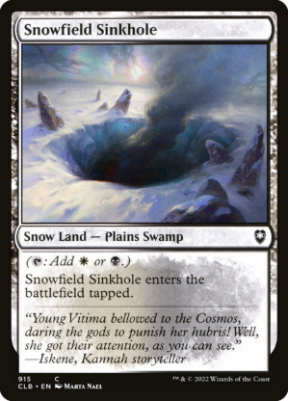
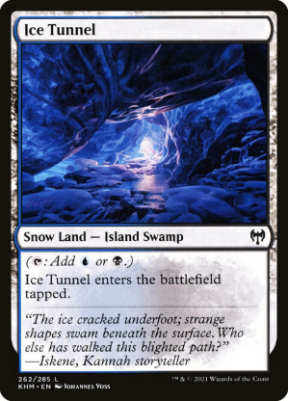
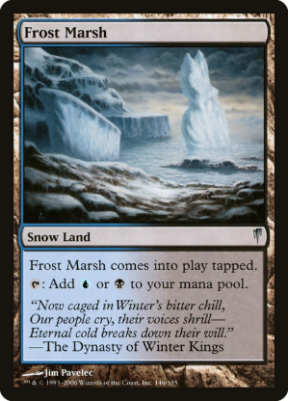
Snow duals are pretty straightforward. They function just like a regular “enters the battlefield tapped” dual land – It comes into play tapped and can make mana of either of the colors it taps for. They’re different because they have the “snow” sub-type, which allows them to contribute snow mana to cards that require it.
Some examples are cards like Ice-Fang Coatl, Blood on the Snow, Icehide Golem, and Abominable Treefolk. There are also basic lands that produce snow mana that can be fetched out with fetch lands. So, if you’re building a Modern snow deck with only a few colors, these may or may not be needed. But hey, they’re here if you do need them.
The cycle of snow duals from Kaldheim has two basic land types, which can make them reasonable budget considerations for people playing domain cards and things like Leyline Binding
Here are all the snow duel lands in the format:
- Ice Tunnel
- Sulfurous Mire
- Highland Forest
- Arctic Treeline
- Snowfield Sinkhole
- Volatile Fjord
- Woodland Chasm
- Alpine Meadow
- Rimewood Falls
- Boreal Shelf
- Frost Marsh
- Tresserhorn Sinks
- Highland Weald
- Arctic Flats
Reveal Lands
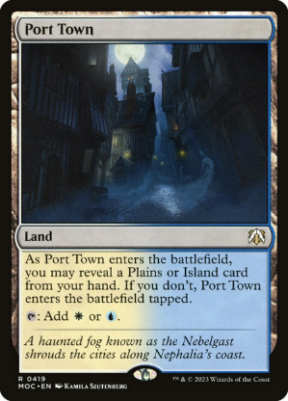
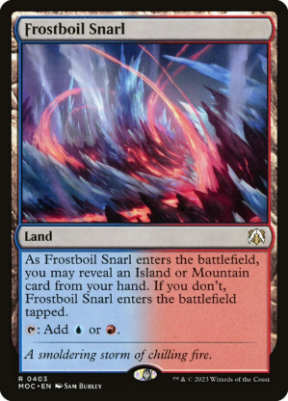
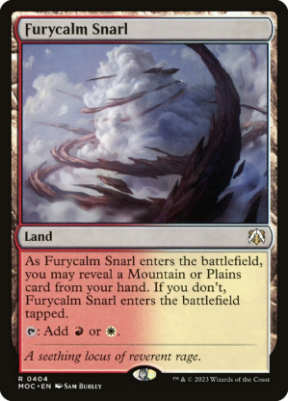
Reveal lands (also called “hand lands,” “show lands,” “flex lands,” “shadow lands,” and “snarl lands”) are dual lands that enter the battlefield tapped unless you reveal a land of one of the types the land could produce. For example, a Port Town produces white or blue and requires you to show a plains or island when you play it.
These are great lands because they’re dual lands that can often come into play untapped, essentially, with no downside. Of course, you’ll have to have a land to reveal, or it will come in tapped without any upside either. So, if you run these, make sure you have ample lands with the requisite land types – This could be achieved with basic lands or other dual lands such as shocks. If you do this, these can be great options for Modern decks.
Below you’ll find the 10 reveal lands in Modern:
- Port Town
- Choked Estuary
- Foreboding Ruins
- Game Trail
- Fortified Village
- Shineshadow Snarl
- Frostboil Snarl
- Necroblossom Snarl
- Furycalm Snarl
- Vineglimmer Snarl
Slow Lands
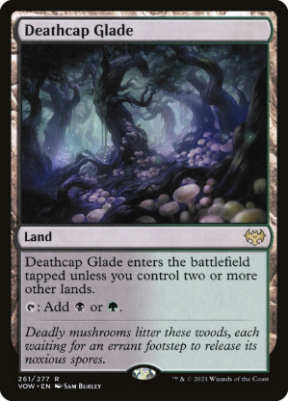
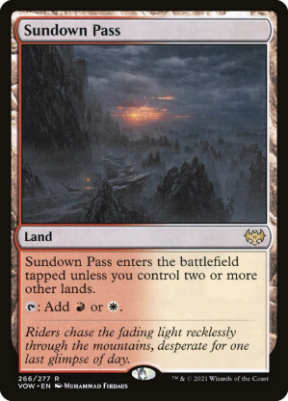
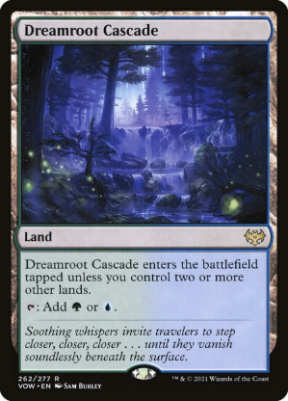
Slow lands are duals that enter the battlefield tapped unless you control two or more lands. Their name refers to the fact that they aren’t great on the first two turns of the game and are, therefore, slow. It’s also a reference, or mirror, of the fast lands that do the opposite and comes into play untapped if you control two or fewer lands.
These are best in slower decks, where you play a very high curve. In these cases, having your lands enter untapped after the first few turns can ensure you have smooth mana as you go into your later turns.
You’ll find a complete list of slow lands here:
- Deserted Beach
- Shipwreck Marsh
- Haunted Ridge
- Rockfall Vale
- Overgrown Farmland
- Shattered Sanctum
- Stormcarved Coast
- Deathcap Glade
- Sundown Pass
- Dreamroot Cascade
Ikoria/New Capenna Tri-Lands
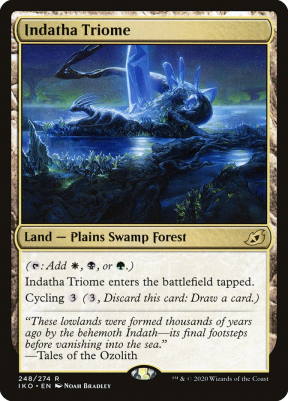
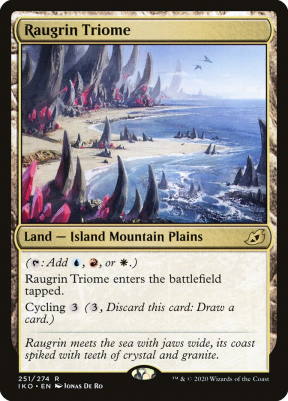
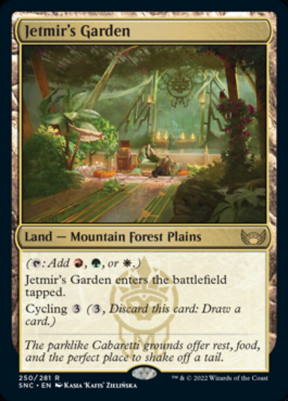
Triome lands are a cycle of land that can each produce three different colors of mana and have basic land types. These lands must enter the battlefield tapped as a downside for this versatility. Additionally, they all possess the “cycling” ability, which allows you to ditch them for a new card if you don’t need land.
These are incredibly powerful and versatile lands. Not only do they provide three colors of mana on a single land but they’re very easy to grab out of your deck early with fetch lands thanks to having so many basic land types. If you’re playing a 3-color or more deck, you’re going to want triomes in your build.
Here is a list of all the “triome” lands from Ikoria and New Capenna:
- Indatha Triome
- Raugrin Triome
- Zagoth Triome
- Savai Triome
- Ketria Triome
- Jetmir’s Garden
- Ziatora’s Proving Ground
- Xabder’s Lounge
- Raffine’s Tower
- Spara’s Headquarters
Utility Lands
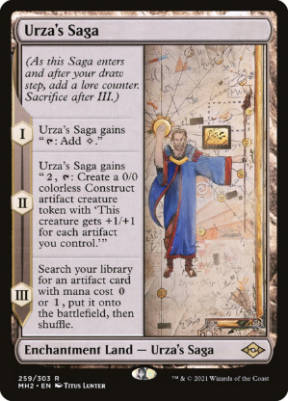
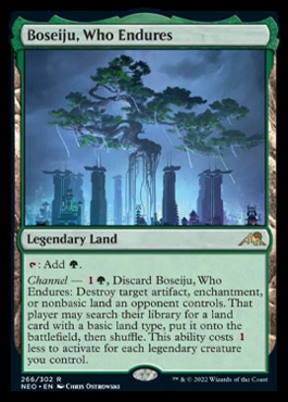
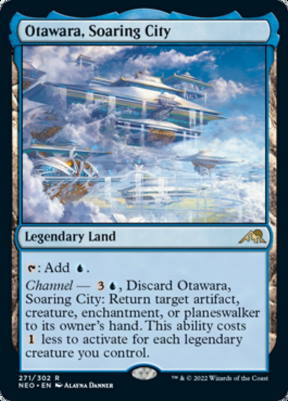
Utility lands do something besides (or in addition to) producing mana. There are so many utility lands in Modern that it would be a monumental task to list them all here. Instead, I’ll cover what makes utility lands so good, when you should and shouldn’t play them, and some of the more played utility lands in Modern.
So, what makes them good? You’re generally getting access to more effects and abilities that go well with your strategy without taking up extra non-land slots in your deck. Take Boseiju, Who Endures as an example. You can play this over a single forest with virtually no downside at all. And have access to main deck artifact, enchantment, and land destruction for a single slot in your mana base.

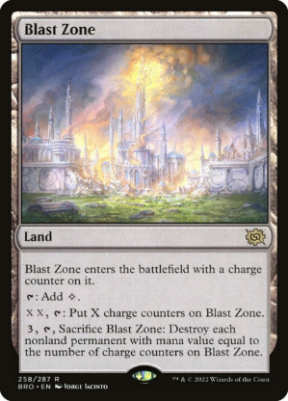
So, why not just pack your deck full of utility lands? Most aren’t without some downside, and some are worse than others. Many lands with impactful abilities don’t tap for colored mana or have other restrictions. Cavern of Souls, for example, can’t produce colored mana for non-creature spells or creatures that fall outside the type you chose when it entered the battlefield.
Blast Zone is a
Here is a list of some common (and not so common) Modern utility lands:
- Access Tunnel
- Arena
- Blast Zone
- Blinkmoth Well
- Bojuka Bog
- Crumbling Vestige
- Dakmor Salvage
- Detection Tower
- Dungeon Descent
- Grove of the Burnwillows
- Hall of Heliod’s Generosity
- Karn’s Bastion
- Magosi, the Waterveil
- Nephalia Academy
- Nephalia Drownyard
- Nimbus Maze
- Quicksand
- Reliquary Tower
- River of Tears
- Safe Haven
- Sanctum of Ugin
- Skyline Cascade
- Smoldering Spires
- The Biblioplex
- Thespian’s Stage
- Tolaria West
- Vesuva
- Academy Ruins
- Boseiju, Who Shelters All
- Eiganjo Castle
- Flagstones of Trokair
- Geier Reach Sanitarium
- Gemstone Caverns
- Gods’ Eye, Gate to the Reikai
- Hall of the Bandit Lord
- Inventors’ Fair
- Kher Keep
- Mikokoro, Center of the Sea
- Minamo, School at Water’s Edge
- Miren, the Moaning Well
- Oboro, Palace in the Clouds
- Okina, Temple to the Grandfathers
- Pendelhaven
- Shinka, the Bloodsoaked Keep
- Shizo, Death’s Storehouse
- Tomb of Urami
- Untaidake, the Cloud Keeper
- Urborg, Tomb of Yawgmoth
- Yavimaya, Cradle of Growth
- Axgard Armory
- Bretagard Stronghold
- Gates of Istfell
- Gnottvold Slumbermound
- Great Hall of Starnheim
- Immersturm Skullcairn
- Littjara Mirrorlake
- Port of Karfell
- Skemfar Elderhall
- Duskmantle, House of Shadow
- Nivix, Aerie of the Firemind
- Novijen, Heart of Progress
- Orzhova, the Church of Deals
- Prahv, Spires of Order
- Rix Maadi, Dungeon Palace
- Skarrg, the Rage Pits
- Sunhome, Fortress of the Legion
- Svogthos, the Restless Tomb
- Vitu-Ghazi, the City-Tree
- Howltooth Hollow
- Mosswort Bridge
- Shelldock Isle
- Spinerock Knoll
- Windbrisk Heights
- Dwarven Mine
- Gingerbread Cabin
- Idyllic Grange
- Witch’s Cottage
- Valakut, the Molten Pinnacle
- Urza’s Saga
- Urza’s Power Plant
- Urza’s Tower
- Urza’s Mine
End Step
There you have it, my friends, a complete overview of Modern lands in MTG. If you’re new to the game, or even the format, the sheer number of lands can be overwhelming. That said, I hope today’s article has been helpful to you in building better MTG decks.
